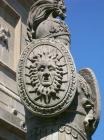27
Detail from Brock's Monument, Medusa with Snake Hair, a Masonic symbol22 June 2009
Queenston Heights Park, Ontario, Canada
 Credits:
Credits:James Black
28
Detail from Brock's Monument, detail of Medusa with Snake Hair, a Masonic symbol22 June 2009
Queenston Heights Park, Ontario, Canada
 Credits:
Credits:James Black
29
Looking up near the statue of the well known Mason General Brock, you will see four soldier statues with angel wings supporting Sir Isaac.30
Detail from Brock's Monument, Soldier Angels Taking Brock to Heaven, built by Freemasons22 June 2009
Queenston Heights Park, Ontario, Canada
 Credits:
Credits:James Black
31
After Brock's Monument was built, it was decided his body would be laid to rest under the monument. According to one source, when Brock's body was moved to his last resting place, the immediate honour guard were members of the Coloured Corps leading black horses. In Port Dalhousie, a section of today's city of St Catharines, where in later years the black community held its annual Emancipation Day Picnics on the1st Thursday of each August - 'Maids Day Off' - this black horse rides the restored historic carousel to this day.32
Black horse from the historic carousel in Port Dalhousie, St Catharines22 July 2009
Port Dalhousie, Ontario, Canada
 Credits:
Credits:James Black
33
Wilma (Miller) Morrison - friend Lois Wade, later Gaskin, at 1941 Emancipation Day Picnic1 August 1941
Port Dalhousie, Ontario, Canada
 Credits:
Credits:Courtesy: Wilma Morrison
34
Wilma (Miller) Morrison - group of friends at 1941 Emancipation Day Picnic1 August 1941
Port Dalhousie, Ontario, Canada
 Credits:
Credits:Courtesy: Wilma Morrison
35
Lakeside Park, St Catharines, site of Emancipation Day Picnics, 1920s-1950s22 June 2009
Port Dalhousie, Ontario, Canada
 Credits:
Credits:James Black
36
Black Masonic Lodge - Niagara Region15 January 2009
Niagara Falls, Ontario, Canada
In the early days of black settlement in Upper Canada the churches were well attended. There were a number of denominations but Baptists and Methodists gained prominence. Blacks settled in separate churches as they often were discriminated against by having to sit separately or out of site in white churches. Overall, their churches were where they gained sustenance to deal with their daily trials.
As numbers grew following the second "Fugitive Slave Act" with an estimated 35,000 blacks coming to freedom in Canada, a number of fraternal organizations followed them. The Black Masonic Lodge was formed in the U.S. by a free man, Prince Hall, in the 1750's and was fully organized by the late 1700's. Hamilton Ontario's Mount Olive Lodge #1 was formed in 1852, with St. Catharines Ontario's Victoria Lodge #2 s and Windsor Ontario's #4 formed in 1853. The female counterpart of the organization is the Order of the Eastern Star. The lodges are still very active today.
The Fraternity of Elks were also very active, particularly in the larger centres of the Province. Members also joined from surrounding communities.
At the turn of the 20th century the Independent Order of Odd Fellows were active in the Niagara area, with membership from along the border of Canada and the United States.
Members of these societies often took leadership roles in bringing about change with respect to some of the inequities within their communities.
Credits:Auhtor: Wilma Morrison
Edited by: K.E. Lyn Royce
37
Black Masonic Lodge Membership Card of Reverend John M Payne7 June 1920
St Catharines, Ontario, Canada
 Credits:
Credits:Courtesy Marlene Jamieson
38
Black Masonic Lodge Annual Meeting Program - Front Cover15 August 1948
St Catharines, Ontario, Canada
 Credits:
Credits:Courtesy Marlene Jamieson
39
Black Masonic Lodge Annual Meeting Program - Page 115 August 1948
St Catharines, Ontario, Canada
 Credits:
Credits:Courtesy Marlene Jamieson
40
Black Masonic Lodge Annnual Meeting Program - Page 215 August 1948
St Catharines, Ontario, Canada
 Credits:
Credits:Courtesy Marlene Jamieson